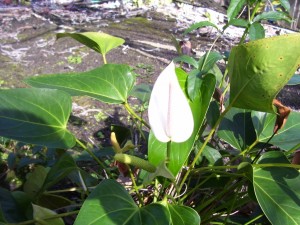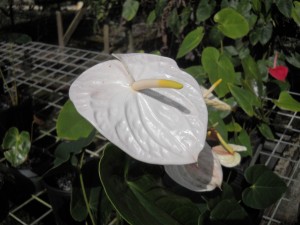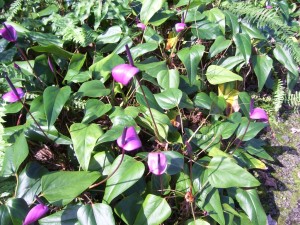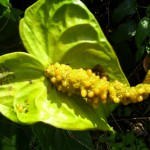Anthurium Flowers and Plants
ANTHURIUMS are one of the most beautiful flowers in the world. ANTHURIUM FLOWERS are produced by ANTHURIUM PLANTS, which are members of the genus ANTHURIUM. This genus consists of over eight hundred ANTHURIUM SPECIES and hybrids like OBAKE ANTHURIUM. ANTHURIUM CARE is easy and consists of finding the right place to put them and watering them properly. HAWAII is one of the first places in the world to grow anthuriums commercially.
How To Grow Anthuriums Outdoors
To start, not everyone can grow anthuriums outdoors. In some parts of the world, due to climate conditions, anthuriums can only be grown indoors. But if you are one of the lucky people to live in a place where the temperature does not drop below sixty degrees, there is a good chance that you will be able to grow anthuriums outdoors.
First, you need to confirm that the region where you live has suitable weather conditions. The temperature must stay between 60 degrees and 90 degrees. These plants may survive for a short while outside of this range, but in general they will be harmed if temperatures go beyond this range. Wind is also a factor. If you live in an area that is windy, the wind may harm your plants. If the leaves on other plants with broad leaves in your area are fine, this means that the wind should not be a concern.
Second, you will need a place that has bright indirect sunlight. These plants can’t handle direct sunlight, but they can’t grow in the dark, either. The ideal location is in a sunny area under a tree that blocks out a portion of the light.
Third, you will need a soil that drains well. These plants do well in just about any soil that has a reasonable amount of organic matter, but the common attribute of any growing medium is that it has to drain well. If it doesn’t, these plants will eventually die of root rot or fungus.
Once you have found or created a place in your garden that meets all of these conditions, all you need to do is take your anthuriums out of their pots and plant them. If you are planting them under a tree, a good way to arrange them is in a circle or semi-circle around the trunk, with roughly a foot between each plant. Finally, make sure that they receive water regularly and they should grow well and produce many beautiful flowers.
Anthurium Care: How To Fertilize An Anthurium
Taking care of an anthurium is easy once you have learned the basics of anthurium care. In previous articles, I have covered where to keep your anthurium and how to water it. In this article I will discuss how to fertilize an anthurium.
Improper fertilization of your plant can kill it, so it is important to learn how to fertilize it correctly. The most important thing to keep in mind is to never over fertilize your plant. If you are uncertain as to how much fertilizer you should give your plant, make sure you give it less than you think it needs. If you over fertilize your plant you can kill it. While, if you under fertilize your plant, the worse that will happen is that it will grow a little slower.
There are two types of fertilizer that can be used to fertilize an anthurium: slow release or liquid. With slow release, you apply it once and don’t have to apply it again for six months. With liquid fertilizer, you will have to apply it every week. In general, I recommend using slow release fertilizer unless you are willing to devote a lot of attention to your plant.
The main thing to look for in a fertilizer is an even ratio of nitrogen, phosphorus and potassium. To find this type of fertilizer, just look at the numbers on the bottle. They should be something like 15-30-15.
Once you have selected a fertilizer, you will need to apply it. To apply it just read the directions on the label and reduce the amounts you see there by 75%. Let’s say that the label says that for 8 inch pots you should apply 1 teaspoon, for an anthurium in an 8 inch pot you should instead apply a quarter teaspoon. As far as application frequency, a slow release fertilizer should be applied once every six months.
Anthurium Species And Cultivars
There are many different anthurium species and cultivars. Many more are being discovered or created each year. This is my guide to the various species and cultivars.
Anthurium Andraeanum Cultivars
Waimea Anthurium
The Waimea is a red anthurium that was created to fill an important need. Red anthuriums are very popular flowers, but the foremost variety of red anthurium, the Ozaki, was decimated by a bacterial blight. The Waimea was created in response to this. It is a blight resistant variety that produces a lot of bright red flowers.
The Waimea was created back in 1987 by crossing Paradise Pink with a Marian Seefurth hydrid. The result was a fast growing plant that produced six flowers a year on average. The Waimea anthurium produces medium sized, heart shaped flowers with a red spathe and a spadix that changes from orange-red to red-purple. The flowers that it produces have a vase life of approximately 28 days.
Centennial Anthurium
The Centennial is a white anthurium that was named for the 100 year anniversary of higher education in the Hawaiian Islands. The Centennial has a lot of symbolic meaning for the University of Hawaii. It produces a white flower with green veins. White and green are the colors of the university. The veins merge together that the base of the flower and this represents the many diverse cultures that have come together at the university.
A lot of work went into the breeding of the Centennial. It is a hybrid that was made from four different species of anthurium: A. andraeanum, A. lindenianum, A. amnicola, and A. antioquiense. It produces a white tulip shaped flower with mild obake tendencies. It has a yellow-green spadix that turns white. As a plant it produces dark green leaves and many offshoots. It is great as a cut flower and as a potted plant.
New Era
The New Era is a purplish-pink anthurium that received its name by being the first blight resistant anthurium. It is ushering in a new era of blight tolerant anthuriums. It has a slightly elongated spathe and a yellow-green spadix that turns white as it matures.
The New Era was a result of crossing three different cultivars. An A494 Anthurium andraeanum was crossed with an A. antioquiense, and the result of this pairing was again crossed with a pink UH507 to produce this lovely flower. It has a long stem and is resistant to both bacterial blight and anthracnose. It was released to cooperating growers back in 2004 and it produces approximately 6 flowers per year. It also has an excellent vase life of 44 days.
Le’ahi
The Le’ahi is a pink and green obake that is named after the Hawaiian name for Diamond Head, the iconic volcanic cone that is a prominent Oahu landmark. The Le’ahi’s keeps its beautiful coloration year-round and produces almost 8 flowers a year. Unfortunately, it is susceptible to blight, so it is a slightly harder variety to grow.
The Le’ahi was created by mixing a child of orange-colored UH931 and a pink-colored Blushing Bride. It is a variety that works well as a potted plant and as a cut flower. Though as a cut flower, some say it has a stem that is a little too short. But its unusually beautiful color pattern, helps to offset its short stems.
Tropic Sunrise
The Tropic Sunrise is a large orange obake flower that was created back in 1981 by crossing an Anuenue with an Soga Orange. It produces a large flower that is orange in the middle and green at the edges that can grow up to one foot long. It has a yellow spadix that turns white as it matures.
The coloration and size of the Tropic Sunrise are its best attributes. It produces its flowers on strong stems that can be up to 30 inches long. Its flowers can last up to 27 days in a vase and the plant produces roughly 6 flowers per year. Testing has shown that it is a strong plant with a slight susceptibility to anthracnose.
White Lady
The White Lady is another amnicola based hybrid. It produces small white tulip shaped flowers that have a tendency to be a little longer than other tulip shaped species. It was created by crossing four different species, so it has quite a mixed heritage. It has small dark green leaves that are shaped like elongated spades. And it makes an excellent potted plant or cut flower.
As a cut flower, White Lady, has a vase life of 25 days. As its flowers age they can develop a pinkish hue, so they look great on potted plants. It is a great plant for growers and hobbyists because it is highly resistant to both anthracnose and blight. It yields approximately 6 flowers a year. The spadix on these flowers can grow to six inches long and their stems grow up to 22 inches. The spadix starts out yellow and changes to green as the flowers mature.
Hokuloa
The Hokuloa is a beautiful white anthurium. In Hawaiian, the word Hokuloa refers to the planet Venus, which is otherwise known as the morning star. It is a brilliant white flower that is worthy of its name. It comes in the standard heart shaped configuration and has a yellow spadix that changes to white as the flower matures. It produces medium five inch wide flowers on stems that are up to 27 inches. It is a hardy plant that is resistant to both blight and anthracnose, so it is relatively easy to grow.
The Hokuloa was created by breeding a Tropic Mist, which produces large cream colored flowers with selection 768-47, which is a hybrid of a Marian Seefurth and an A. antioquiense. This created a plant with glossy white flowers that are resistant to rain damage. It grows well in tissue culture and produces roughly 6 flowers per year. It has an excellent 37 day vase life, so it makes a great cut flower.
Hilo Moon
The Hilo Moon is another white anthurium with a celestial name. It is closely related to the Hokula and is in fact a sibling of it as they share the same parents. Sometimes, when you cross two plants, you get several child plants that are worth cultivating. Like actual siblings, you can see the resemblance, but they have their own unique qualities.
The Hilo Moon looks almost like the Hokuloa, except it is slightly less symmetrical. It is the same white color and it has the same yellow spadix that changes to white as the flower matures. It has a higher yield and can produce up to 8 flowers per year, but unfortunately its flowers have a shorter vase life, only 22 days, compared to 37 days. It shares a resistance to blight and anthracnose and it produces more offshoots than its sibling.
Anthurium Species
There are more than eight hundred species of anthurium plants in the world. But what is even more remarkable is that more species are being discovered each year. So the ultimate number of anthurium species may be much higher than eight hundred. Of these eight hundred species of anthurium, only four species are sold commercially. And these four species can be lumped into two categories: foliage or flowers.
Foliage Species
The two species grown for foliage are: Anthurium Crystallinum and Anthurium Faustinomirandae. A. Crystallinum normally produces large two foot long leaves. Its leaves have a smooth surface and dark green color that is punctuated by pale, white veins. While, A. Faustinomirandae has even larger green leaves that are very thick and sturdy. Its leaves can be up to five feet long.
Anthurium Scherzerianum
The first species grown for their flowers is Anthurium Scherzerianum. A. Scherzerianum is a plant that is very difficult to kill and hence it is a great choice for a novice anthurium grower. It produces a large number of flowers, but its flowers are not as impressive as the flowers produced by A. Andreanum. Usually its flowers are small, white and have a curly orange nose.
Anthurium Andraeanum
And the second species grown for flowers is Anthurium Andraeanum. Almost all of the flowers that you will see in a flower shop will be members of this species. Back in the 1940’s, Hawaii’s anthurium growers discovered that they could breed anthuriums selectively. This led to explosive growth in the number of varieties of anthurium flowers.
Anthurium Watermaliense
Anthurium Watermaliense gets its name from the town of Watermall, which is in Belgium. Watermall was the town where this plant was first taken after being collected in Columbia. It is also known as the “black anthurium”, though it really isn’t black. It produces flowers that are dark purple, which I suppose can be mistaken for black in the dim light of a jungle. The distinguishing characteristic of this species is a stipe, which other anthuriums do not possess. A stipe is a piece of stem that offsets the spadix from the spathe on these flowers. On other anthuriums, the spadix emerges directly from the spathe.
Anthurium Plowmanii
Anthurium Plowmanii is named after botanist Timothy Plowman, who has discovered and catalog a large number of plants from the Amazon. It grows in various parts of South America at elevations ranging from sea level to 3000 feet and it tolerates dry conditions much better than many other members of the anthurium family. It is sometimes called Anthurium Plowmanii Ruffles or Anthurium Fruffles, possibly because of the wavy shape of its leaves. It can grow to a decent size and grows in what is sometimes called bird’s nest form; if you use your imagination it kind of looks like a bird’s nest for perhaps a pterodactyl.
Anthurium Magnificum
Anthurium Magnificum is aptly named, it produces large and magnificent leaves. It’s olive green leaves with silver veins can grow up to two feet long and the surface of its leaves has a velvety texture. The main way to identify this species is to look at the petiole; members of this species possess square shaped petioles. In the wild, this species is only found in Columbia, but it is capable of growing in many other parts of the world. And many people grow it because of the beautiful leaves that it produces. It makes a great ornamental plant.
From their humble beginnings in Central and South American rain forests, anthurium plants have come a long way to Hawaii, and they haven’t stopped there. Now they are cultivated commercially in: Holland, Mauritius, Costa Rica and many other parts of the world. And they have a bright future as growers are continuing to breed incredible new varieties.
Anthurium Care: How To Care For Anthurium Flowers
Proper anthurium care is easy; for the most part, you only need to address two basic factors to keep your anthurium plants healthy and you only need to avoid making three deadly mistakes to ensure that they stay alive.
The two factors that are vital for ensuring healthy anthurium plants are: the location where your keep your plant and the way in which you water your plant.
Once you have addressed these critical factors, all you have to do is avoid making the three deadly mistakes that I cover below and you will be well on your way to ensuring that your anthurium plants remain healthy.
Best Location For Anthuriums
If you want to keep your anthurium flowers healthy, you have to keep them in the right place. Anthuriums come from South American rainforests and can be harmed if they are not kept in conditions that resemble their ancestral home.
In the rain forest, anthuriums generally encounter temperatures between 70 and 90 degrees and humidity between 80 and 100%, plus they either live on the forest floor or grow on trees and so they are shaded from direct sunlight.
So, first, you have to be sure that your plant is never put in a location that freezes. Frost will kill your plant. Temperatures below 55 degrees are bad for your plant and it should ideally be kept at temperatures above 70 degrees. In addition, your plant should not be allowed to get too hot. Temperatures above 90 degrees are too hot and can also harm your plant.
Second, you have to try to ensure that your plant receives the proper amount of humidity. Humidity between 80 and 100% is ideal. But a little lower is fine as long as you water your plant regularly.
Third, you must make sure that your plant is not exposed to direct sunlight. Direct sunshine can harm its leaves and flowers. However, you do want it to receive a fair amount of light, so that it can grow well.
So, what is the best way to achieve these two conditions? The first thing you can do to ensure that your plant is kept at the proper temperature is to keep it indoors. Assuming that you keep your house between 70 to 90 degrees, your plant will find the temperature agreeable. The second thing you can do give your plant the proper humidity is keep it in the bathroom. When you take a hot shower, you will also be providing plenty of humidity for it. If you don’t want to keep your plant there and you live in a dry climate, consider keeping your plant in a room with a humidifier. Finally, keep it near a window that receives a lot of light, but make sure that it does not receive direct sunshine. If the edges of its leaves are becoming bleached or are turning brown, move it a little further away from the window to prevent them from being burnt by excessive sunlight.
Watering Anthurium Plants
Anthuriums are used to growing in tropical rain forests. The key word in the previous sentence is rain. They are used to receiving water on a daily basis. However, they are not accustomed to standing water. They typically grow on trees. So what happens is rain falls on them and it immediately drips off, it does not pool around their roots. This allows their roots to receive moisture, while also receiving exposure to air. The exposure to air is critical. This prevents the growth of anaerobic organisms that can harm them.
So the key when it comes to watering anthuriums is to water them regularly, while at the same time allowing their roots to receive air.
We can accomplish this by using a good potting soil. The ideal potting soil is light, fluffy and has to drain well. You can use just about anything as long as it meets this last criteria. Everything from sand, perlite, bark, volcanic cinder and gravel can be used to help meet this requirement.
Once you have the proper potting soil nailed down. You have to make sure that the water can drain completely out of the pot. If you have your pot in a tray, you have to make sure that you empty the tray after watering.
Do not overlook the importance of adequate drainage. The deadliest mistake of all is forgetting to water your plants, but arguably the second deadliest mistake is allowing their root system to remain soaked in water. When their roots are left in water, this prevents oxygen from reaching their roots and when this happens anaerobic microbes and fungal growth will occur and cause root rot. Left unchecked root rot will kill your plants.
Finally, we get to the actual watering of your plant. The general rule is water it everyday. As long as your pot drains completely after each watering, it is almost impossible to over-water your plant. If you have the time and live in an area with low humidity, you should also mist the leaves of your plant. Just spritz them with water twice a day.
Fertilizing Anthurium Flowers
Anthuriums need to be fertilized periodically, but you have to be careful not to over-fertilize them. This can be a deadly mistake. When fertilizing your plants, always err on the side of under-fertilizing them. If you give them too little fertilizer, the worse that will happen is that they will grow slower and produce fewer flowers, and if you see this happening you can easily fix this by giving them a little more fertilizer. But if you give them too much fertilizer they can die.
Aim to fertilize them once or twice per year depending on how long the growing season in your region lasts. Use a fertilizer with a ratio of 5-10-5 and apply roughly a quarter of what the label recommends. This ratio is ideal for ensuring a good balance between foliage and flowers. If you were to use a fertilizer with high nitrogen like, 15-10-5, you will get a bunch of leaves but fewer flowers. And when choosing a fertilizer, go for a slow release variety. This way you only have to fertilizer your plants once or twice per year, rather than once a week if you were to use a liquid fertilizer.
Conclusion
In conclusion, anthurium care is simple. Just put your plants in the proper location and water them properly. Avoid the three deadly mistakes of: forgetting to water them, over-fertilizing them and allowing water to collect around their root system; and you will have no problem keeping your anthurium plants in great shape.
Anthuriums
The genus Anthurium is a member of the family Araceae and may consist of up to 1,000 species. Since the members of this genus grow in the Amazon rainforest, which has yet to be fully explored, many new species continue to be discovered each year. Some people mistakenly believe that this genus is also native to Asia, but plants found there appear to have been introduced by humans.
Members of this genus grow in tropical rain forests that receive abundant rain fall. They can be found growing on the ground or on trees. They can grow in many forms, but the most prevalent forms are bushes or vines, attached to trees. They can grow from seeds or as offshoots of parent plants. Offshoots are genetically identical to parent plants, while seeds, even if produced by self-pollination may not be exactly identical to their parent.
All members of Araceae produce an inflorescence or spadix, where both male and female portions of the flower are present. Self pollination does not occur, unless a plant produces multiple flowers at different times because the stigma and the stamen are active at different times. The spadix is surrounded by a spathe, a modified leaf, which is mistakenly thought to be the flower by some, whereas the spadix is the true flower of the anthurium.
Anthuriums may be grown for their leaves or for their flowers. They can be grown outdoors in tropical climates or indoors in colder climates. Warmer temperatures, 65 to 80 degrees, are required, and freezing temperatures will damage these plants. They grow well in moist, but not saturated soil, with a lot of humus. Direct sunlight will harm them, so keep them in bright indirect light.
They are most commonly propagated by taking cuttings. A cutting should have at least two growing nodes that consist of bunches of roots and leaves. It should be placed in a mix of peat moss and perlite or sand and watered regularly. They may also be propagated by seed, but the production of seed will often require an expert’s skill and patience; since the process from pollination to seedling may take up to a year and a half.










